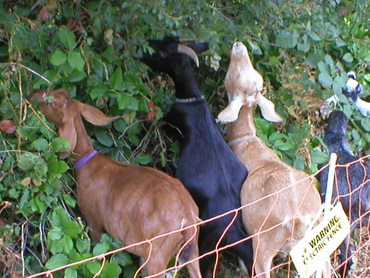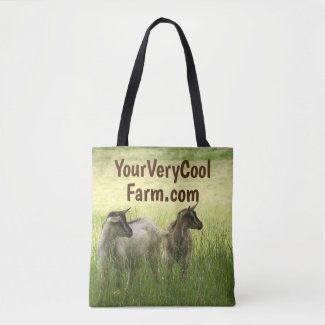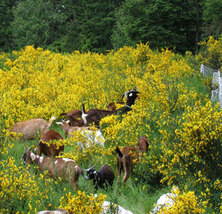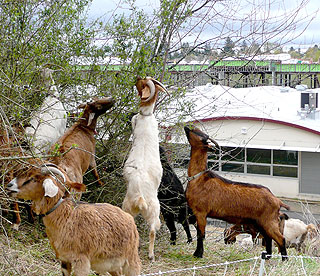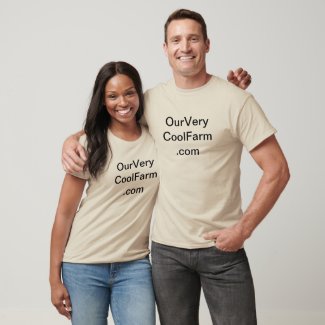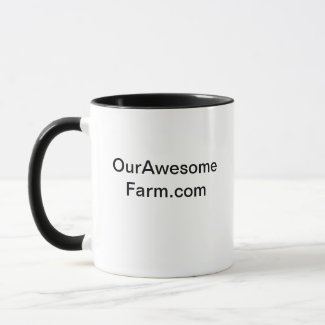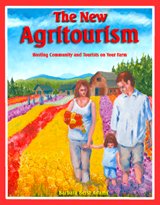Looking for a goat brush clearing business to hire -- or want to start your own?
Originally published in AcresUSA by Barbara Berst Adams
Copyright National Lilac Publishing, LLC
Ever wonder if brush clearing goats could benefit to your property? Can they help protect from wildfires? Also, could such ruminants be a viable sideline or full time rural business of your own? These questions will be explored here. The use of goats (sometimes along with sheep and cattle) is a growing brush-clearing trend in a world seeking environmentally friendly and cost effective methods for keeping land healthy.
Goats can be excellent at reducing fire hazard, thinning understory beneath timberland so mature trees can grow stronger, and eliminating non-native invasive plants on public lands and on private farms and ranches. They can climb into areas that would be difficult for machinery or even a human on foot with hand equipment to reach. Other advantages are that debri from land clearing doesn’t have to be removed -- because the goats ate it -- with the debri replaced by fertile goat manure. When using goats instead of large machinery for clearing, permits for heavy equipment are not required, and the goats’ digestive systems eliminate the viability of seeds that pass through them, whereas mechanical clearing methods would leave viable weed seeds in the ground. Goats have even been used to restore wetland habitats. In Carroll County, Maryland several years ago, goats were rented to remove invasive plants from a wetland that was the habitat of the endangered bog turtle. Heavy equipment and herbicides would have further harmed the turtles.
How one rural goat owner started a successful brush clearing business
The use of goats for clearing land has become so popular in some locations, that landowners are able to start goat renting businesses and/or find goats to rent if they want to test the waters without owning goats of their own. Rent-A-Ruminant, LLC is a successfully owned ruminant land clearing service owned by Tammy Dunakin. Her seven-acre property is located on Vashon Island, which is a rural region near Seattle, Washington. “I currently have about 120 working goats and about 12 retirees,” Dunakin said. Though she lives in a rural setting, her goats have been transported and used to clear an eccentric list of locations including inner city schools and submarine bases. Her current success was achieved by considering and acting on an “aha” moment she received years ago, and then a willingness to get through the tough spots of starting a business.
Dunakin had grown up with farm animals. “I had a small farm as a kid with horses, cows, a goat, and poultry,” she said. “I was a horse obsessed kid. I was in 4-H with my horses and FFA in high school.” But as an adult, Dunakin had become a paramedic and eventually worked in a trauma and burn intensive care unit. She was seeking a change of careers when the idea for the goat brush clearing business was sparked.
“I was living on Vashon Island, Washington, which is a small rural island that is accessed only by ferryboat and about a 15 minute ride from west Seattle. I had a small farm which I have had since 1989. At that time I had two horses and a couple of goats.
“One day I came home from an exceptionally grueling day at work and went out in the pasture to see my goats. I thought they looked bored. I said to them out loud ‘You guys look bored, you need a job. I am going to start a business named Rent-A-Ruminant and hire your little butts out so that you’re not bored and so that I can quit my job.’ It literally made me laugh out loud. I told people about this light bulb moment and they laughed, too, but always following the laughter they would say, ‘Wow, that is a great idea.’ ‘I bet it would do really well here.’ I thought so, too.”
The business idea had been planted. “I took no action at the time,” she said. “But, it lived in the back of my mind as I went about my normal work-a-day routine. As the months turned into a year and the year turned into two years, I found myself absolutely desperate to get out of the trauma center. One day around this time I was in line for an espresso,” she said. “I did not want to be working for someone else anymore but I could not figure out what I could do that would bring me joy and that I could feel really excited about. A question for myself popped into my head. ‘What is it you wanted to do or be when you were a kid?’ The answer was ‘I wanted to be a farmer and work with horses and other animals.’ Then, the next thought was a light bulb and ding, ding, ding... the Rent- A-Ruminant business.
“So, I started trying to figure out how I would do it. At the time there was one other person doing the business in Washington state. He was out of eastern Washington.” Washington state is divided by a mountain range that creates a dry desert on the east side and a wetter, even rainforest climate in some locations on the west side. Dunakin, living in western Washington, decided to move forth with the business. “There was really not any place to learn about it. No books had been written and I was not a user of the internet much so did not even think of doing a Google search. I soon got a gig with the island parks department to do a job at a very popular park. As soon as I did that, the island newspaper did a feature front page story on us, and we were off!
“I worked on the island for two years exclusively as I wanted to get much better at it and, really, the thought of going off island to work kind of nauseated me.” (Her island, remember, is accessed only by ferryboat. Hauling goats on a ferry could seem like a challenge, among other challenges of hauling goats to unfamiliar urban territory.) “I soon learned, however, that the amount I was charging versus the amount of time spent working was not as good as I had hoped. I got a call from a "green" construction company in downtown Seattle around that time, they had a job on a steep hill consisting of old growth Himalayan blackberry they wanted the goats to munch down. That ended up being my first foray into working off my little island and gave me a taste of the income potential that this business could generate. I was saying to myself, ‘they are paying me this much to do this? Wow!’ The rest is history.”
Where goats can and cannot be used for brush control
Goats are built to eat many unwanted plants -- such as thorny invasive blackberries -- that other animals won’t touch. Also, their digestive systems allow them to eat some plants that are toxic to other animals or humans. They are widely reported to even eat poison oak and poison ivy (keeping in mind that humans who touch goats recently exposed to these plants risk picking up the itch.) However, there are some plants that are toxic to them, and others that are not toxic, but they just don’t eat, or prefer not to eat if plenty of other more preferred plants are available. In one experiment in North Carolina according to “Using Goats for Brush Control as a Business Strategy” published by the University of Arkansas and authored by David Fernandez, extension livestock specialist, “Brush cover was reduced while desirable grasses and legumes increased from a low of 16 percent to over 50 percent of the plant ground cover. In a separate study, multiflora rose was found to be almost completely eliminated by the fourth year of browsing. Keep in mind that there are some species that goats will not eat. For example, in one study, nimblewill, wild strawberry and yellow crownbeard cover actually increased because the goats would not eat them and they faced less competition from other brush and weed species”
Goats can also certainly eat many plants the landowner doesn’t want killed, however, and will eat the bark from trees in certain situations, such as when they run out of their preferred brush. If landowners want to keep mature living trees healthy, timing and a close watch on the goats’ progress would be of importance.
As well, along with some plants that are poisonous to goats, some situations pose other types of danger. The goats and their supervisors themselves must avoid locations that can harm them. “We cannot do areas with a lot of toxic vegetation such as rhododendron, laurel, azalea, poison hemlock, large quantities of bracken fern, and more, depending on the region,” Dunakin said. “We can’t do sheer cliffs. We can do steep slopes, however the wrangler has to be able to climb them to put up the fencing. They are not great in areas with a lot of downed trees that are like pickup sticks as it is very hard to put up fencing, and that situation is a hazard to goats for leg injuries.” She said that areas that are completely wet or soggy without any dry land for the goats to access and too much muck to walk through should be avoided. “They can do pond management,” she said. “They tend to avoid the water -- but not always. Mine have waded in it to eat cattails and watercress that floats on the water.” Goats also, obviously, cannot do areas with chemical spills or land with other dangerous substances.
No one would allow goats to clear brush in areas where they have access to desirable crops or landscape plants they love to eat, such as blueberry plants, fruit orchards, and ornamental roses. Goats, however, are sometimes actually used to purposely strip the bark of younger understory tree species in certain areas such as timber woodlots, and trained to leave the desired mature trees alone (search online “Goats in the Woods Project” at Cornell University for more about this). They’ve even been used by homesteaders to purposely strip the bark off cut downed lodgepole pines so the bark-free logs can be used for fencing or building furniture.
Best breed of goats, where to obtain them, and off-season housing
Healthy goats no longer wanted by their owners offer a source of “workers” for Dunakin’s business. Owners can be happy the goats are going to a good home where they’ll live out their lives doing what goats naturally want to do. Certain types of goats seem the best suited for the brush clearing operation, though. “I obtain most of my goats when people call me trying to find a home for their unwanted goats. I call this rescue because most of these animals would have potentially ended up in bad situations or the slaughter house. I also get occasional calls from the local goat rescue when they have a goat that is just too wild to adopt out. My herd is a great alternative in these cases. I have also had a couple of goats find me. Once I was on a job in Tacoma, Washington, in the city. Some people stopped by who had just found a young and very wild goat running in their neighborhood. They could not find the owner so asked me to take him. That is how I got Petey. He came blind in one eye and most likely was going to be someone’s meal. I have bought a handful of goats over the years when I have needed to bump up the size of my herd quickly. But probably 75% are rescues. I got another goat when I was doing another job. The neighbor had a goat who was very lonely because his friend had died. They asked if I would take him and that is how I got Skippie.
“Most breeds of goats can do vegetation management no problem. Fainting goats are not good because they would spend all their time fainting. I don’t like to use Angora due to their hair getting stuff caught in it. Other than that, the only breed issue has to do with the goats’ hardiness as a breed. Some breeds such as Nubians and Oberhasli are not easy keepers. I have a hard time with parasites with them as well as general health stuff. They are hard to keep healthy. Super good breeds are Boer, Spanish breeds, Kinder goats and mixed breeds. Pygmy breeds are no problem and are actually beneficial as they can get inside of areas larger goats cannot and eat from the inside out. That said, it is important to not have just small breeds because they cannot eat up high enough.”
In some cases, sources for weeder goats can also come from the goat dairy industry as was described by Sue Brown, owner of Amaltheia Organic Dairy in Belgrade, Montana. Being a cheese producer, Amaltheia needs as much milk as it can produce from its goats, so the owners had to find an appropriate outlet for the excess male goats at a young age to keep their care from cutting into their milk and profits. “The goats start kidding in January and as always, 50% are males,” Sue said. “Because we are in need of milk, we cannot afford to feed the bucklings as well as the doelings. Goats usually have singles their first kidding and then twins after that. Some have triplets and we have had three sets of quadruplets this year, which is unusual. We give away the males at about five to thirty days old. People come from all over the Northwest to pick them up, as goats are great noxious weed eaters and private citizens as well as government programs pay to have goats graze off the weeds. Those who come have experience in bottle-feeding goats, and may have a milk cow or other goats to provide milk for the bucklings.”
Depending on the location, brush eating goats may have an off-season to deal with during inclement weather such as snow and heavy rain. “My goats live on my property on Vashon Island during the winter months, Dunakin said, who has two high quality barns on her acreage. “I have them on about an acre total because I do not want them eating short winter grass and picking up parasites. I pretty much "dry lot" them in the winter. They have a paddock and the barns to hang in. They hate the rain which we get a lot of here in the Seattle area so they hang in the barns a lot. They also have to be fed 100% (during this time). My goats (including her retired goats -- which she allows to continue living out their lives) eat about 40 tons in the winter months of good quality hay. The barns are set up with feeders, making feeding easy.
“The retired goats pretty much always stay at my farm’s ‘the old goats home’ section. I have very rarely tried to find them other great homes but have a couple of times. I like to keep them because I want to make sure they are really well cared for and can relax and just be old and happy.”
Fencing and liability
Fencing may have been one of the biggest challenges for Dunakin when starting up her goat brush clearing business. She described how her fencing issues started from the very beginning: “I had purchased a couple of goats from a friend, and with about six goats total, I went to do a test job at a local person’s property. It was a joke! I tried to use hog panels and T-posts to configure the pen. On one end, the blackberries were so thick and dense I thought, ‘Oh, I can just leave that end without a fence ‘cause there is no way they are ever going to be able to tunnel through that stuff.’ Ha! By the next day they had escaped exactly that way by tunneling through. I rounded them up, put them back in and thought to myself, ‘This is too damn hard.’
“I realized there was no way I could do a business if I could not find a better way to fence the goats in. This led me to the internet where I discovered that indeed there was such a thing as electrified netting for sheep and goats. I order a few rolls and when it came I took it to the job and put it up. Hahahahaha! They ran right through it even when getting zapped! I put them back in and they did it again! I was ready to pull my hair out. I went back to the maker of the netting and said, ‘This stuff is crap!’ They then proceeded to ask me if I had read the instructions to which I said, ‘Uhhhh, no.’ I figured it out after that and was able to fence them somewhat effectively but it was still not as goat proof as I had hoped.”
Today after much trial and error, Dunakin seems confident in her fencing strategy, which she combines with the act of always being watchful of the goats on their jobs. As far as getting the power needed for electric fencing to remote areas, even that type of power can be portable. “I use a 12 volt battery-operated energizer of good quality” Dunakin said. “I charge the batteries as needed but they last a couple weeks at least between charges.”One source for weeder goat owners on fencing supply and how-to information may be found in information on rotational grazing that’s customized to the goat owners’ own location through local agriculture extension publications or workshops. Rotational grazing with goats raised for fiber, meat or dairy has some similarities with tending goats for brush control in that the goats are frequently moved to new territory, often with temporary electric fencing.
When using electric fencing, the publication “Rotational Grazing” published by ATTRA Sustainable Agriculture and authored by Alice E. Beetz and Lee Rinehart, suggests that pre-training the animals to the electric fencing in smaller paddocks at first may be of value. “Producers sometimes use a special paddock for introducing new stock into the (electric fence) system,” it states.”Once animals learn to respect the electrified wire, it becomes a psychological rather than a physical barrier.” Goats, however, can be bolder and more inquisitive than some other livestock species. Also, goats moved within the property already familiar to the rotational grazing ranch owner would have less hazards to watch out for than those moved to brand new unfamiliar territory. For certain situations, it is best that solid fencing is already in place. “We have to be careful next to freeways,” Dunakin said, “and should use a solid fence as often as possible in these situations.”
Liability to the goat owner -- such as goats escaping onto roadways or entering and eating neighboring fruit orchards must be addressed. “Of course there are concerns about liability,” Dunakin said. “We have very good liability insurance coverage. It is a must! Also we focus a lot on prevention of escape. An ounce of prevention is worth its weight in gold. This means we are very diligent with our electric netting for not only keeping goats in but also keeping predators out. We also live on site in almost all cases to keep an eye on our herds and to be close in case of escapes or other problems. Nothing is a 100% guarantee that there won’t be the rare escape. For that reason we are hyper vigilant at keeping an eye on things.”
According to David Fernandez’s report mentioned above, “The insurance company’s attorneys can often help you recognize potential problems and advise you about the best course of action to avoid legal problems.” Fernandez also points out that one may need to shop around for the proper insurance company for various reasons such as, for example, if livestock guardian dogs are used. “In some cases,” the report states,”your insurer may not allow you to use guardian dogs, and your losses to predators may become unacceptably high. There are insurers that allow guardian dogs, and you should make the effort to find them.”Landowners who rent goats to clear brush on their property may also want to check with their own insurance company regarding if they, as landowners, might be liable for damages to the goats, to the goats’ supervisors, or even if the goats escape and cause damage elsewhere. Both parties involved would need to know upfront whose insurance covers which situations.
-----
The use of goats for clearing invasive species and excessive brush is not new. According to the Encyclopedia of New Zealand, early settlers once rounded up feral goats into paddocks to clear problem blackberries and gorse. But in spite of the toughness and versatility of goats long used for brush clearing, they do have certain non-negotiable needs including hoof care and specific minerals unique to their species. Domestically owned goats definitely need intelligent care to thrive. But once goat owners understand how to keep them healthy, these animals can be of enormous benefit to keeping agriculture and other land parcels ecologically productive and safer from wildfires when the goats are properly managed. Whether people use their own pet goats to improve their own small holding, rent larger numbers of goats to clear and manage their larger property, or even start a goat weeding business of their own, the use of these ruminants can be a humane and eco-beneficial land management solution.
More on using goats to reduce fire hazard
According to the Union of Concerned Scientists, wildfire numbers are increasing and the wildfire season is getting longer. Gary Pfalzbot is the author of “Developing a Weed and Brush Control Program with Goats” published by Goatworld.com. In it he states, “For the past decade or more, the use of goats for controlling weedy and brushy areas that provide fuel for fire has greatly increased. Such control is called mitigation.”
“Goats are an awesome way to mitigate wildfires,” Tammy Dunakin said. “They eat underbrush that is a huge fire hazard, especially in areas that are hard to maintain by traditional methods. They also will stand on their hind legs to eat the lower branches of trees -- also reducing the fire hazard from them. They can reach six to seven feet up.”
As described by the Washington State University extension, “In unthinned forest stands there are often many little trees in the understory. These small trees act as a “ladder” for fire and help carry it up into the crowns of bigger trees. Once a fire travels into the crown, tree death almost always occurs. These ladder fuels should be removed through thinning.” And also, “Tree branches that hang low to the ground are another kind of ladder fuel. Pruning the lower branches of trees can reduce the possibility of fire while improving aesthetics and timber quality. Increasing the distance between the ground and the lowest branches reduces the likelihood that a fire will move from the ground into the crown of a tree; a 10-foot “lift” is generally recommended for reducing this risk.”
Also, the danger of slash piles leftover from mechanical thinning debri causing extra fire hazard is eliminated when goats eat the debri and replace it with moist, fertile goat droppings.
Starting a goat land clearing business, including the franchise option
Landowners interested in operating a ruminant land clearing business have as one option, to start and operate on their own as did a founder of We Rent Goats®, who started the business after choosing to leave a lifetime in the cattle business. As another option, aspiring goat clearing business owners can purchase a franchise from an existing business that offers that opportunity. For example, the Rent a Goat™ business founded in 2010 at one time offered a franchise opportunity, although their current contact methods have been cut back due to overwhelming responses to their business.
Tammy Dunakin has also chosen to expand her business by offering a franchise opportunity to other ruminant owners. She said she even consulted with one person about renting out his camels (camels are also ruminants.) Franchisees would be allowed to use the Rent-A-Ruminant (RAR) brand name, and would receive both initial and ongoing support from Dunakin.
“A farmer would benefit greatly from becoming a franchisee,” she said. “First off, I have spent 12 years developing the RAR brand. We are rated very high in the search engines due to an enormous amount of ongoing press both nationally and internationally.”
Dunakin sees branding as very beneficial to start-up businesses. “Branding means they come into a company with a history of good business and a great reputation,” she said. “It means consumers can go find this history on the internet and have confidence that the company they are hiring has a good, honest and known reputation.
“Secondly, you get trained and mentored in every aspect of your business from A to Z. You also get ongoing support forever. It is very hard to break into a fledgling industry in a niche market. There are tons of mistakes one can make, especially when working with animals. With the franchise they do not have to make the mistakes because quite frankly, I have pretty much made every one, so they don't have to.”
Dunakin’s program comes with guaranteed territories, websites, and marketing plans with all the written manuals for each plan and powerpoint presentations for each. It comes with resources for finding the proper insurance, equipment, fencing etc. Dunakin feels these and other resources her franchise offers, including connections her business has made, would be attractive to those looking into renting out ruminants as fire mitigation and brush control.


